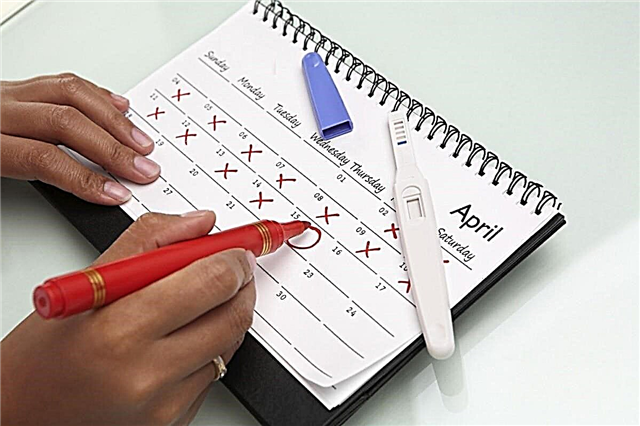
To actively develop imagination, thinking, attention and fine motor skills in childhood, they use interesting games, which include "Tangram". Such a useful and addictive puzzle game is perfect for the development of preschoolers.

There are many game schemes according to which the child will be happy to collect cats, houses, fish and many other figures. In addition, the game does not have to be bought in the store, since it can be made for preschool children with your own hands. To do this, it is enough to define goals and objectives, and then print pictures for classes.
Features:
A game called Tangram was created in China many centuries ago. She has several legends of her origin. According to the most common of them, the puzzle was invented by three wise men for the son of the emperor, not interested in learning. The capricious prince liked "Tangram", the game helped him to comprehend the basics of mathematics and philosophy.
The game is represented by a set of seven figures. It includes five triangles of a certain size (two of them are large, two are small, and one is medium), one parallelogram and one square. The figures themselves are flat and can be folded into a large square.
The essence of the game lies in the fact that from the available elements you need to add a more complex figure, for example, an animal, a number, a person, a building. The clue is usually the outer outline or silhouette of the folded figure. The game is suitable not only for preschoolers - it will be interesting for both older children and adults.
Goals and objectives
Solving the puzzle, they are guided by the following main rules:
- the finished piece must include all seven elements of the game;
- used flat figures cannot be superimposed on one another;
- all elements must be connected to each other.
Having given the child a set in hand, you need to show each of the figures, explain their name, size, color. Further, the preschooler is offered a diagram of some image, after which the child must impose individual elements on the proposed drawing.
To begin with, such a scheme should be in full size, so that it would be easier for the baby to find a place for each Tangram figure.

A more complex option will be only schematic hints - small schemes without boundaries, along which the child will navigate during the task.

If the kid does an excellent job, you can move on to the most difficult thing - folding the figures by name. The child is simply told that he needs to fold (for example, some kind of animal), and he independently creates a given figure to his taste. This is an interesting task, because many different figures can be assembled from the same simple set of elements. Here are several options for playing Tangram:
- Come up with a story or a fairy tale for a child, the plot of which will be based on several characters. It is their figures that the kid will have to compose in the process of narration. For example, the child will assemble a house as the first figure, and then, in turn, will create its future inhabitants - a bunny, a fox, a dog, a duck.
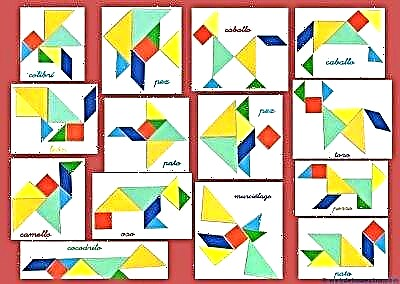
- If a child is crazy about cats, suggest to him collect as many as possible from the elements of "Tangram" these cute animals.

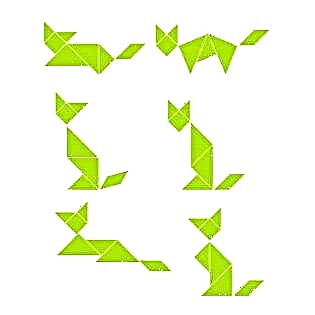
- It will be no less interesting to play the builder. During this game, the child will collect different types of houses. Tangram allows you to create a huge number of variations of various buildings. You can design a house for someone, for example, for your grandmother or for your pet.

Benefit
Playing Tangram is useful for several reasons:
- folding the figures develops visual-figurative thinking and imagination;
- the game teaches an understanding of shapes and sizes, as well as counting;
- completing the task, the child improves perception and attention;
- if the figures are multi-colored, then they also give preschool children an understanding of color;
- thanks to the collection of different figures, combinatorial abilities are improved, the child understands how to divide objects into parts;
- "Tangram" develops fine motor skills well, which helps to improve brain activity and speech;
- thanks to folding the puzzle, the child becomes more patient and assiduous, which prepares him for school.
In addition, such an educational game will help diversify activities in kindergarten. In addition, it can be great fun for the whole family, because there are a great many tasks and possible combinations.

How to do it yourself?
The "Tangram" puzzle can be found in stores, but you can easily make it yourself, using thick cardboard as a basis. You can print the template below and transfer it to cardboard or draw a diagram with your own hands.
If you will be coloring the tangram by hand, use the light version so that the borders after coloring are not visible.


You can also print tangram in color on thick printed paper or thin paper, pasting it with tape after printing - thereby making it stronger.
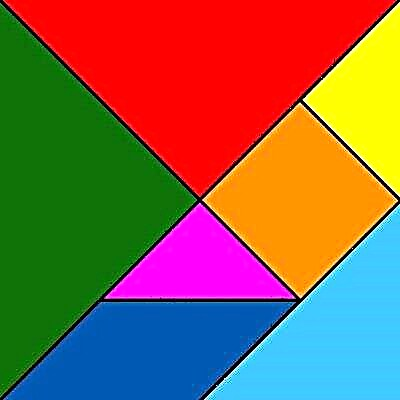
How to draw a tangram?
Instead of cardboard, a plastic office folder, a plastic disc box, plywood or other handy material will also work for making game elements.
A diagram of how to draw a square drawn on cardboard to end up with seven elements is quite simple to create. For example, take a 10 cm square, draw a diagonal that divides it into two equal large triangles. Divide one of them with the second diagonal in half, as a result of which you get the first 2 details - large triangles.
From the second triangular half of the square, we will need to make the remaining 5 shapes. First, mark the middle of each side of the square. By connecting these points, you get the middle triangle. Next, mark the middle of the diagonal and put two more points in the middle of each of the resulting segments (all these points will divide the diagonal into 4 equal segments).
By connecting the lowest of these points to the sharp end of the middle triangle, we get the first small triangle. If you draw a line from the midpoint of the diagonal to the hypotenuse of the middle triangle, you get a small square. Now it remains to connect the highest point on the diagonal and the middle of the hypotenuse of the middle triangle. The result will be another small triangle and parallelogram.
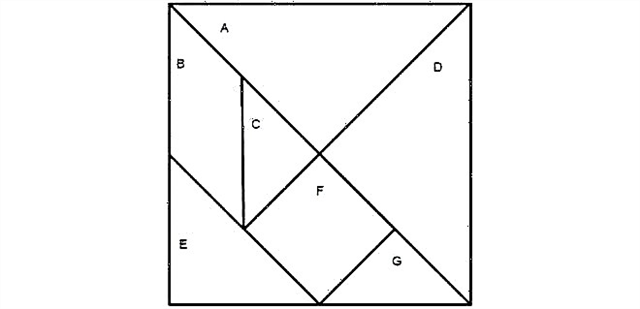
For the little ones, it is recommended to print out the color "Tangram" at once on the printer, so that it would be easier for children to navigate in the game.
If you have printed several sets, we recommend storing each one separately.
Schemes and templates
Separately, it is necessary to prepare sheets with templates on which the kids will lay out geometric shapes. Depending on the age, drawn on such a template the figure can be divided by lines, to tell the child the place of each individual detail. In addition, for clarity, you can print drawings or photos of real objects, the images of which are to be collected, for example, a drawing of a fox, a Christmas tree or a house.

Older children are encouraged to offer pictures in which the composing figure is represented only by a general outline, so that the baby himself determines how to decompose the elements. If the child already copes well with such options, print out sheets with schematic images of small size for classes, looking at which he will be able to compose the desired drawing from all the elements of "Tangram".
As a rule, the option with borders is enough for preschoolers. But if your child has already mastered this level of difficulty, invite him to collect tangrams without specifying clear boundaries.









You can see the step-by-step process of creating a tangram in the following video.



